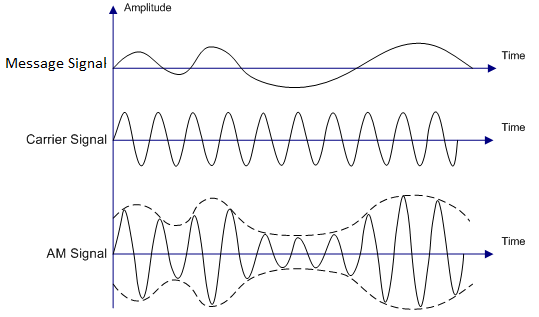
Answer
393.6k+ views
Hint: The ease of decoding the message at the receiver’s end plays a big part in deciding which type of modulation is to be used for broadcasting. Since broadcasting is done to a large mass of receivers, it is necessary that the simplest technology and machinery is implemented which is easily available to the masses.
Complete answer:
Amplitude modulation is a process in which a message (modulated) signal is transmitted via a channel by enveloping it with a carrier signal of much greater frequency. In this way the carrier signal carries the main message signal along with it and does not allow it to be lost due to energy dissipation by the medium in which it travels.
The below graph of the message signal, carrier signal and modulated signal plotted against time will make the concept clearer.

Amplitude modulation has been used for many decades especially in radio broadcasting. One of the most important factors which promoted the use of amplitude modulation in radio broadcasting is the simple machinery and circuitry required at the receiver’s end. A simple diode circuit is enough at the receiver’s end to properly receive the modulated signal and get the original message.
Since, while broadcasting, there are a large number of receivers which are the common masses of public, it is essential that the machinery and circuitry involved be simple and compact so that everyone can accommodate and use it properly.
Amplitude modulation serves this purpose perfectly as explained above and hence is used for broadcasting.
So, the correct answer is “Option C”.
Note:
Students might think that why is modulation even necessary? Without it, won’t the process become even simpler, since there will be no need for decoding the message at the receiver’s end. However, this is not true since the message signal is usually of a low frequency (and high wavelength) which suffers greater attenuation (dissipation of energy by the medium). Enveloping it with a carrier wave of higher frequency, the attenuation is small (since the wavelength of the carrier wave is small) and hence, the message signal also travels without much attenuation and is received completely on the receiver’s end.
Complete answer:
Amplitude modulation is a process in which a message (modulated) signal is transmitted via a channel by enveloping it with a carrier signal of much greater frequency. In this way the carrier signal carries the main message signal along with it and does not allow it to be lost due to energy dissipation by the medium in which it travels.
The below graph of the message signal, carrier signal and modulated signal plotted against time will make the concept clearer.

Amplitude modulation has been used for many decades especially in radio broadcasting. One of the most important factors which promoted the use of amplitude modulation in radio broadcasting is the simple machinery and circuitry required at the receiver’s end. A simple diode circuit is enough at the receiver’s end to properly receive the modulated signal and get the original message.
Since, while broadcasting, there are a large number of receivers which are the common masses of public, it is essential that the machinery and circuitry involved be simple and compact so that everyone can accommodate and use it properly.
Amplitude modulation serves this purpose perfectly as explained above and hence is used for broadcasting.
So, the correct answer is “Option C”.
Note:
Students might think that why is modulation even necessary? Without it, won’t the process become even simpler, since there will be no need for decoding the message at the receiver’s end. However, this is not true since the message signal is usually of a low frequency (and high wavelength) which suffers greater attenuation (dissipation of energy by the medium). Enveloping it with a carrier wave of higher frequency, the attenuation is small (since the wavelength of the carrier wave is small) and hence, the message signal also travels without much attenuation and is received completely on the receiver’s end.
Recently Updated Pages
Who among the following was the religious guru of class 7 social science CBSE

what is the correct chronological order of the following class 10 social science CBSE

Which of the following was not the actual cause for class 10 social science CBSE

Which of the following statements is not correct A class 10 social science CBSE

Which of the following leaders was not present in the class 10 social science CBSE

Garampani Sanctuary is located at A Diphu Assam B Gangtok class 10 social science CBSE

Trending doubts
Which are the Top 10 Largest Countries of the World?

A rainbow has circular shape because A The earth is class 11 physics CBSE

Fill the blanks with the suitable prepositions 1 The class 9 english CBSE

How do you graph the function fx 4x class 9 maths CBSE

Give 10 examples for herbs , shrubs , climbers , creepers

In Indian rupees 1 trillion is equal to how many c class 8 maths CBSE

The Equation xxx + 2 is Satisfied when x is Equal to Class 10 Maths

Difference between Prokaryotic cell and Eukaryotic class 11 biology CBSE

What is BLO What is the full form of BLO class 8 social science CBSE




